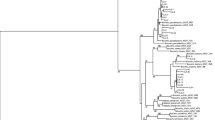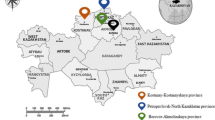Abstract
A survey carried out over Western Kenya in order to determine the prevalence of microorganisms in cereal stem borers and legume pod borer showed the presence of a large number of insect pathogens in the dead larvae. Larval cadavers were recovered from all sampling sites. Bacterial and fungal microorganisms were highly prevalent. Other major groups of microorganisms were also recovered, although at a low level. Viruses (polyhedral inclusion bodies and granulosis viruses) occurred at 2.7% at the Mbita Point Field Station, and 1.1% in the field. Mermithids and rhabditids occurred at 0.4% in the station and 0.6% in the field, whereas the protozoans (microsporidia and gregarines) were more prevalent in the station than in the farmers’ fields (9.4 and 1%, respectively).
The spotted stalk borer, Chilo partellus was the most common borer sampled, but Busseola fusca and legume pod borer, Maruca testulalis were sampled in most sites too. Sesamia calamistis and Eldana saccharina were recorded at a low level, and C. orichalcoceliellus was recorded only at the Kenya coast.
Résumé
Une étude faite à l’Ouest du Kenya pour déterminer la fréquence des microorganismes des insectes foreurs de tíges des céréales et de d’agents pathogènes dans les larves mortes. Des cadavres larvaires ont été collectés dans tous les sites de collections. Des microorganismes bactériens et des champignons microscopiques étaient hautement prédominants. D’autres groupes important de microorganismes ont été aussi retrouvés, quoique à un nombre réduit. Les virus ont été detectes ceux-ci representaient 2,7% à Mbita Point et 1,1 % sur le terrain. Les Merthimidae et les Rhabditidae representaient 0,4% à la Station de Mbita Point et 0,6% sur le terrain. Par contre les protozoaires (microsporidies et gregarines) étaient plus abondant à la station (9,4%) que sur le terrain (1%).
Le moucheté Chilo partellus était le plus commun des insectes foreurs de tiges, suivis de Busseola fusca et Maruca testulalis. Sesamia calamistis et Eldana saccharina ont été retrouves à un niveau très bas. C. orichalcoceliellus fût collectionné seulement à la côte Kenyanne.
Similar content being viewed by others
References
Andreadis T.G. (1984) Epizootiology of Nosema pyrausta in field populations of the European corn borer (Lepidoptera Pyralidae). Environ. Entomol. 13, 882–887.
Andreadis T.G. (1986) Dissemination of Nosema pyrausta in feral populations of the European corn borer, Ostrinia nubilalis. J. Invertebr. Pathol. 48, 335–343.
Entwistle P.F., Adams P.H.W. and Evans H.F. (1977a) Epizootiology of a nuclear polyhedrosis virus in European spruce sawfly Gilpinia hercyniae: The status of birds as dispersal agents during the larval period. J. Invertebr. Pathol. 29, 354–360.
Entwistle P.F., Adams P.H.W and Evans H.F. (1977b) Epizootiology of a nuclear polyhedrosis virus in European spruce sawfly Gilpinia hercyniae: Birds as dispersal agents of the virus during winter. J. Invertebr. Pathol. 30, 15–19.
Entwistle P.F., Adams P.H.W. and Evans H.F. (1978) Epizootiology of a nuclear polyhedrosis virus in European spruce sawfly (Gilpinia hercyniae): The rate of passage of infective virus through the gut of birds during cage tests. J. Invertebr. Pathol. 31, 307–312.
Funderburk J.E., Boucias D.G., Herzog D.C., Sprenkel R.K. and Lynch R.E. (1984) Parasitoids and pathogens of larval lesser cornstalk borers (Lepidoptera, Pyralidae) in northern Florida. Environ. Entomol. 13, 1319–1323.
Hill R.E. and Gary W.J. (1979) Effects of the microsporidium, Nosema pyrausta, on field populations of European corn borers in Nebraska. Environ. Entomol. 8, 91–95.
Huger A. (1961) Methods for staining capsular virus inclusion bodies typical of granuloses of insects. J. Insect Pathol. 3, 338–341.
Odindo M. O., Otieno W.A., and Oloo G.W. (1988) Infection and mortality of the cereal stem borer Chilo partellus Swinhoe, Busseolafusca Fuller, Sesamia calamistis Hampson, and Eldana saccharina Walker on sorghum. Discovery and Innovation (In press).
Odindo M. O. (1983) Epizootiological observations on a nuclear polyhedrosis of the African armyworm Spodoptera exempta (Walk.). Insect Sci. Applic. 4, 291–294.
Poinar Jr. G.O. (1975) Entomogenous nematodes, a manual and host list of insect nematode associations. (Edited by Brill E.J.) Leiden.
Roberts D.W. and Yendol W.G. (1971) Useof fungi for microbial control of insects. In Microbial Control of Insects and Mites. (Edited by Burges H.D. and Hussey N.W.), pp. 125–149 Academic Press, London.
Seshu Reddy K.V. (1983) Studies on the stem-borer complex of sorghum in Kenya. Insect Sci. Applic. 4, 3–10.
Tanada Y. (1961) The epizootiology of virus diseases in field populations of the armyworm Pseudaletia unipuncta Haworth. J. Insect Pathol. 3, 310–323.
Author information
Authors and Affiliations
Rights and permissions
About this article
Cite this article
Odindo, M.O., Otieno, W.A., Oloo, G.W. et al. Prevalence of Microorganisms in Field-Sampled Borers on Sorghum, Maize, and Cowpea in Western Kenya. Int J Trop Insect Sci 10, 225–228 (1989). https://doi.org/10.1017/S1742758400010377
Received:
Revised:
Published:
Issue Date:
DOI: https://doi.org/10.1017/S1742758400010377




